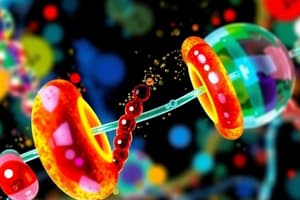Podcast
Questions and Answers
What molecules are produced when ATP is hydrolyzed?
What molecules are produced when ATP is hydrolyzed?
- ADP and oxygen
- ADP and inorganic phosphate (correct)
- ATP and water
- ADP and glucose
ATP is a permanent energy storage molecule.
ATP is a permanent energy storage molecule.
False (B)
What is the typical energy release from the hydrolysis of one mole of ATP?
What is the typical energy release from the hydrolysis of one mole of ATP?
7-12 kcal
The process of breaking the high-energy phosphate bonds within ATP is called ______.
The process of breaking the high-energy phosphate bonds within ATP is called ______.
Match the following cellular activities with their significance related to ATP hydrolysis:
Match the following cellular activities with their significance related to ATP hydrolysis:
Which enzyme catalyzes the hydrolysis of ATP?
Which enzyme catalyzes the hydrolysis of ATP?
The electrostatic repulsion between the phosphate groups in ATP makes the high-energy bonds stable.
The electrostatic repulsion between the phosphate groups in ATP makes the high-energy bonds stable.
What is the biochemical equation representing the hydrolysis of ATP?
What is the biochemical equation representing the hydrolysis of ATP?
Flashcards
What is ATP?
What is ATP?
ATP, or adenosine triphosphate, is a crucial molecule in cells responsible for transferring energy. It's like the cell's energy currency.
What is ATP hydrolysis?
What is ATP hydrolysis?
ATP hydrolysis is the breaking of the high-energy phosphate bonds within ATP by adding a water molecule. This process releases energy.
How does ATP's structure relate to its function?
How does ATP's structure relate to its function?
ATP's three phosphate groups are linked by high-energy bonds. Breaking these bonds (hydrolysis) releases energy to power cellular activities.
What happens during ATP hydrolysis?
What happens during ATP hydrolysis?
Signup and view all the flashcards
How much energy is released during ATP hydrolysis?
How much energy is released during ATP hydrolysis?
Signup and view all the flashcards
How is ATP hydrolysis important to cellular processes?
How is ATP hydrolysis important to cellular processes?
Signup and view all the flashcards
What are coupled reactions?
What are coupled reactions?
Signup and view all the flashcards
How is ATP replenished?
How is ATP replenished?
Signup and view all the flashcards
Study Notes
Introduction to ATP Hydrolysis
- ATP (adenosine triphosphate) is a crucial molecule in cellular energy transfer.
- Hydrolysis of ATP, breaking high-energy phosphate bonds in ATP, releases significant free energy.
- This released energy powers various cellular processes and reactions.
Structure of ATP
- ATP consists of an adenine base, a ribose sugar, and three phosphate groups.
- High-energy phosphate bonds are between phosphate groups.
- These bonds are unstable due to electrostatic repulsion between negatively charged phosphate groups.
ATP Hydrolysis Reaction
- ATP hydrolysis adds a water molecule.
- ATPases catalyze the reaction.
- The reaction is highly exergonic (releases energy).
- ATP + H₂O → ADP + Pi + Energy (ADP is adenosine diphosphate, Pi is inorganic phosphate).
- Energy release is substantial and measured in kilocalories per mole.
Energy Released during Hydrolysis
- Hydrolysis of one mole of ATP typically releases 7-12 kcal of free energy.
- This energy difference is significant compared to other metabolic reactions.
- Energy released varies slightly with conditions and cellular environment.
Significance of ATP Hydrolysis
- Energy from ATP hydrolysis is essential for:
- Muscle contraction
- Active transport across cell membranes
- Protein synthesis
- Cell signaling
- DNA replication
- Nerve impulse transmission
- ATP hydrolysis energy fuels endergonic reactions.
Coupled Reactions
- Endergonic reactions need energy input.
- ATP hydrolysis provides this energy.
- ATP hydrolysis energy drives endergonic reactions, facilitating them.
Regeneration of ATP
- ATP is not permanent energy storage.
- Rapid ATP breakdown requires replenishment.
- ATP regenerates from ADP and inorganic phosphate through cellular respiration, photosynthesis, or fermentation.
- Regeneration maintains cellular energy availability.
Factors affecting the energy of ATP hydrolysis
- Temperature
- pH
- Cellular environment (e.g., magnesium, potassium, calcium concentrations)
- Enzyme regulation
- Other metabolite presence (inhibitory or stimulatory)
Summary
- ATP hydrolysis is a crucial process for releasing energy for cellular work.
- The released energy significantly drives many endergonic reactions.
- ATP is continuously regenerated to maintain consistent energy availability in cells.
- The process is tightly regulated and affected by various factors.
Studying That Suits You
Use AI to generate personalized quizzes and flashcards to suit your learning preferences.




